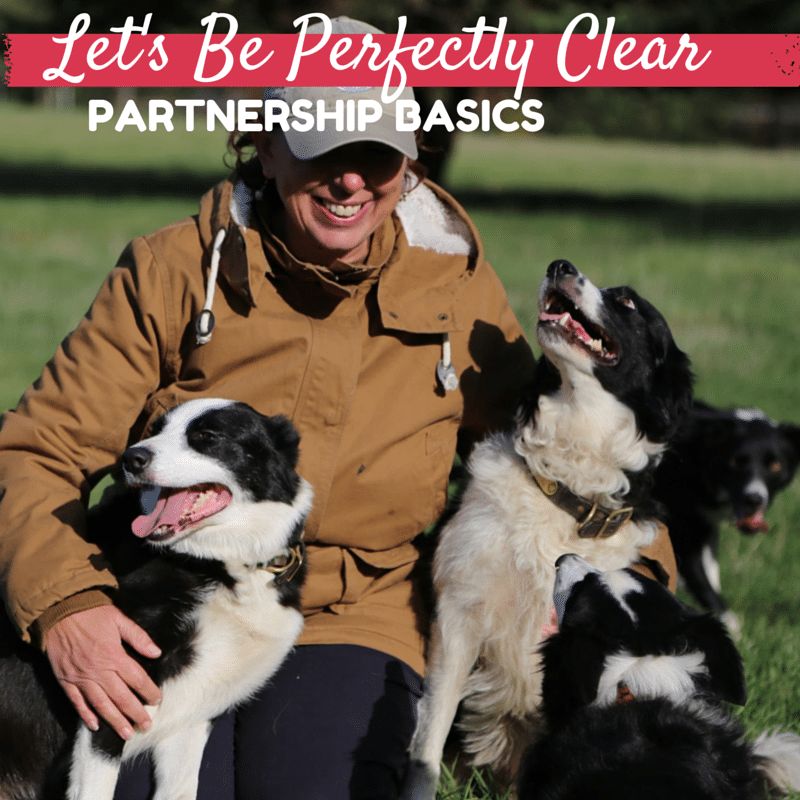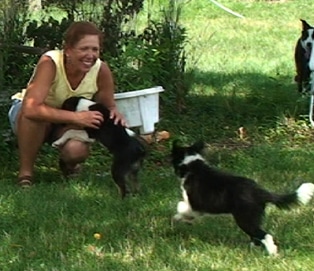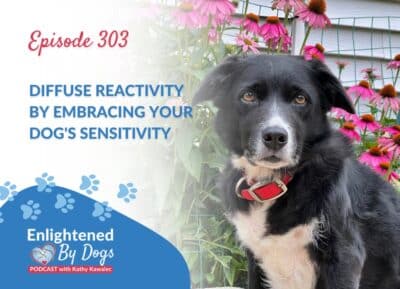Clarity leads to each partner taking responsibility for their part of the partnership…intuiting what the other wants and needs. It’s a beautiful thing!
If you’ve been around me for more than a minute, you’ve probably heard me speak about “Clarity” and how important that is to training our dogs. But, what does that mean, how do we do that, and how is it applied to our training?
clar·i·ty
[klar-i-tee] noun.
clearness or lucidity as to perception or understanding; freedom from indistinctness or ambiguity.
In order to deliver clear information, there are a few things that we need to take into account.
1. Bridging the Language Gap.
Establishing a common language between dog and human is crucial to communicating clearly. That seems so simple, yet it’s an often overlooked aspect of training. Because we humans are taking the lead with the training process, it is our responsibility to learn to ‘speak’ to our dogs in a way that they can understand.
We know that dogs naturally communicate by reading body language, expression, movement and direction. We know that we want to teach our dogs to respond to hand signals and verbal (audible) cues, since that is our natural communication style. But how do we bridge that gap effectively, in a manner that encourages partnership and an eagerness to seek understanding?
I suggest we establish a ‘common language’ that is based on the native communication skills of our dog…which is, fortunately, also part of the communication toolbox of humans!
Start by using appropriate body language, expression, movement and direction to communicate our desire to our dogs…and then we begin to name (assign a verbal/audible cue) to the active response by the dog…and ultimately fade out much of the body language and movement as the dog becomes fluent at responding to our verbal cues or whistles.
This common language gives us the foundation upon which we can build the skills that are necessary for the required task.
For example: we crouch down and move invitingly away from our puppy to encourage her to move towards us, right into our open, palm up and soft hands. Eventually, that becomes our recall. And, it becomes a cue to move toward us with the sheep in between as we are developing a gather. That ultimately leads us to be able to call our dog in smartly to hold off a single sheep.

Mindfully and artfully used, we have now established a solid language that communicates two fundamental skills: move in and move out. We will be using this language for the most basic foundation skills on up to mastery of advanced skills. And, so it goes with ALL of the language we will be establishing with our dogs. This system can be used to build skills for any sport or activity and for every-day life.
2. Communicate with Intention.
In order to provide clarity to our dogs, we need to establish our intention. It’s like your declaration of a course of action that you intend to follow…and an objective that will guide your actions. Dogs clearly read our intention and the way they do this is by reading the minutia of our communications. It’s in the tiniest of details in our body language and expression. It’s the same way they read the sheep.
Our lack of attention to those same details is what makes our timing off, our communication sloppy and ultimately what causes our dogs to not “listen” to what we are saying. If we take a moment to be clear in our own heads and bodies about what our objective is in the present moment, then our intention will be clear to us and to our dog.
For example:
• Do you want your dog to flank correctly right now, or do you really just want the dog to get over to the side so you can let the sheep in the gate? Your intention will communicate to your dog what you really expect, no matter what you are saying audibly.
• Do you really want your dog to lie down right there? Or, do you mean that he should turn in at balance and move the sheep towards you? When you have clear intention, your dog will better understand what you are asking for and you will be more likely to help your dog to rehearse good moves.
• Do you want your dog to think and take initiative for what to do? Or, do you want your dog to just listen to your instructions? Your mindful intention makes all the difference in how your dog will respond in each situation.
3. Congruency brings Clarity.
The most direct path to clearly communicate with your dog is to be congruent: All aspects of you are in harmony, without conflict or disorder. That means: what you are thinking, how you are feeling, what your body is doing, and what your voice and expression are telegraphing must all be the same. Or at least really similar.
In order to be congruent, we must be mindful and aware of all of the aspects of ourselves. That is a learned behavior and requires intention and much practice. Lots and lots of practice. Speaking from my own path of experience, I can say that it takes determination, persistence and patience to learn to BE congruent. At least the majority of the time. OK, maybe a little more than half of the time. It’s one of life’s HARDS.
Dogs know when we are congruent and when we are not. When we’re not, they are confused. That confusion translates into different things for different dogs in different circumstances. Some dogs distract themselves by eating grass or poo. Other dogs get fast and frantic. Or stop and look back at their handler.
For example, if we want our dog to lie down, we can’t be thinking about stopping that breaking ewe. When we want to create ‘flow’ for a shed, we can’t be focused on stopping the leader.
Communicating with ALL of ourselves is what will help our dogs to understand what we want, and will help them to willingly comply. This is critically important in the beginning and intermediate stages of training and if done well, leads to a breath-taking dance where you and your dog seem to be like one.
 Clarity leads to:
Clarity leads to:
Each partner taking responsibility for their part of the partnership…intuiting what the other wants and needs.
It’s a beautiful thing!
Click the Banner to Download Your Free Book and get on my VIP Subscriber list for the latest tips and insights:
 Experience Success in all you do … sports, performance and every day life.
Experience Success in all you do … sports, performance and every day life.
This FREE guide will teach you 5 Core Principles that will help you:
- Identify and Solve Your Dog Training Challenges.
- Get the Performance Results You Want.
- Be a Fun, Confident, Attentive Trainer that Your Dog Adores!


 Clarity leads to:
Clarity leads to:




8 Responses
Learn to whistle better :0)
So glad to see someone in herding addressing solid behavior and training.
Thanks for stopping by, Kay!!
So great to read this. In my world where most dog owners are simply their dog’s friend and not a sport/work partner, I rarely see an understanding of clarity. In a very simple example, when their dog does something RIGHT, they never reward. But when the dog does something WRONG, they always show frustration and sometimes, punishment (with words). I am perpetually telling other peoples’ dogs how good they are when they DO respond to their owners — I hope they get the message but so often they do not.
Thanks for the heads up Kathy. If “I” am not exactly clear as to what I want/need to have the dog do, how can I teach them to do it?
I love what you wrote here! I have been working with my 3 yr old BC and are starting pro-novice. This is a first for me so it is taking awhile! What if we started poorly but are starting to build trust – clarity sounds great and hope it’s not too late!
dogs are great observers, so we are communicating, even when we do not realize it.
Excellent reminder to personally center myself so I can be clear with my signals.